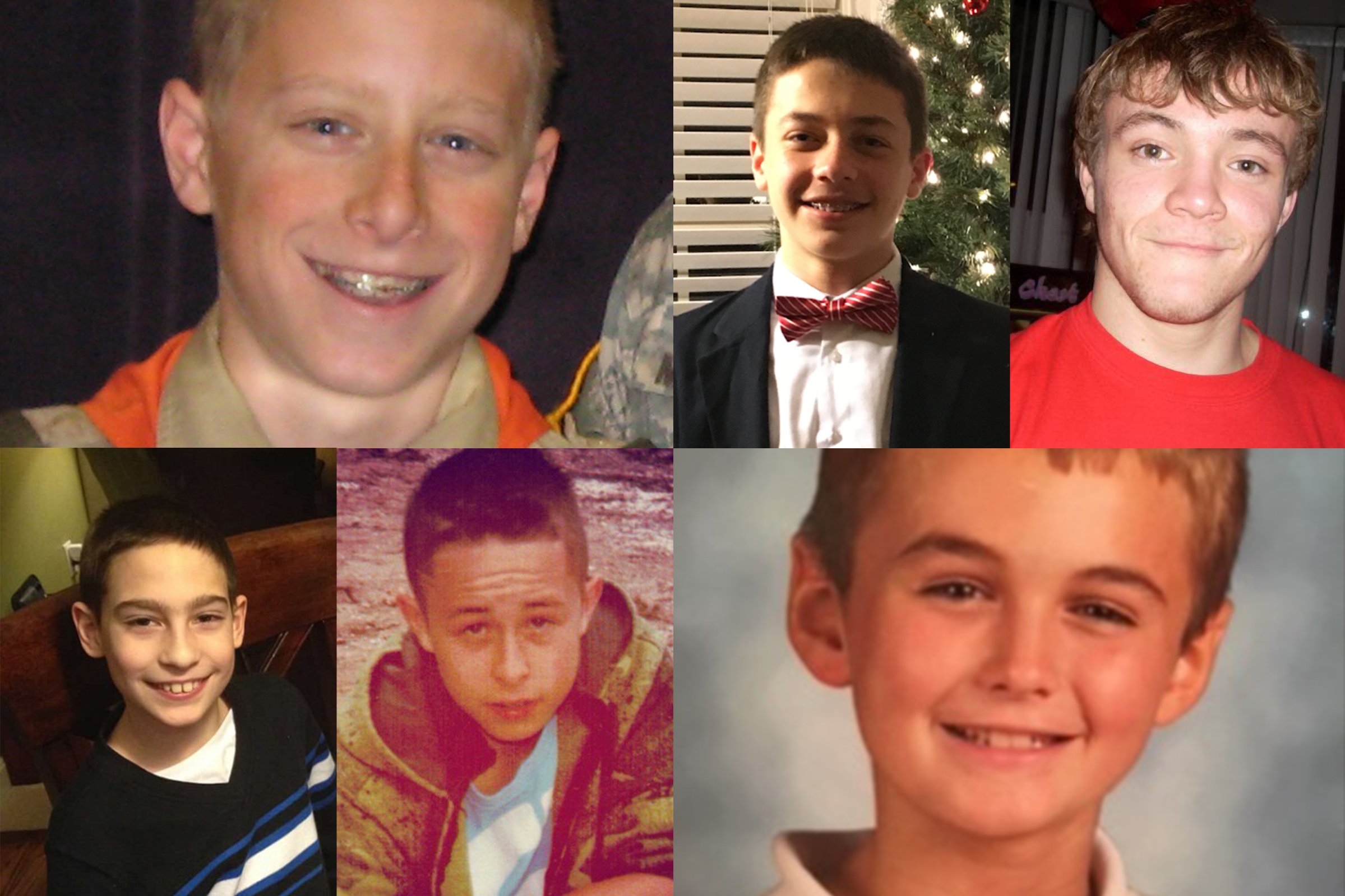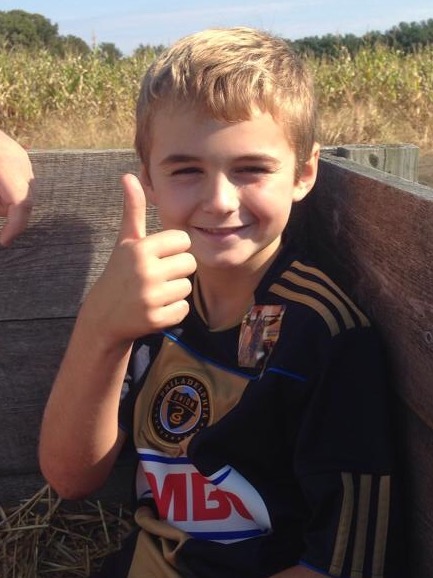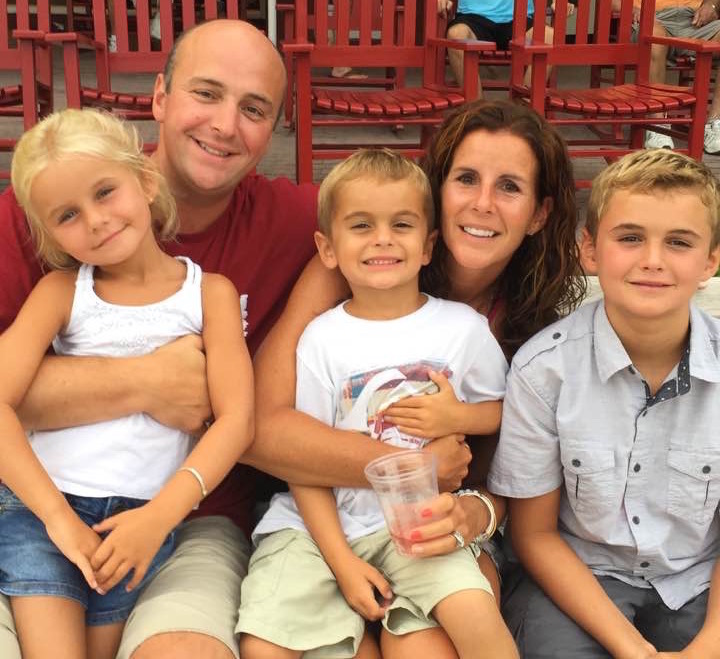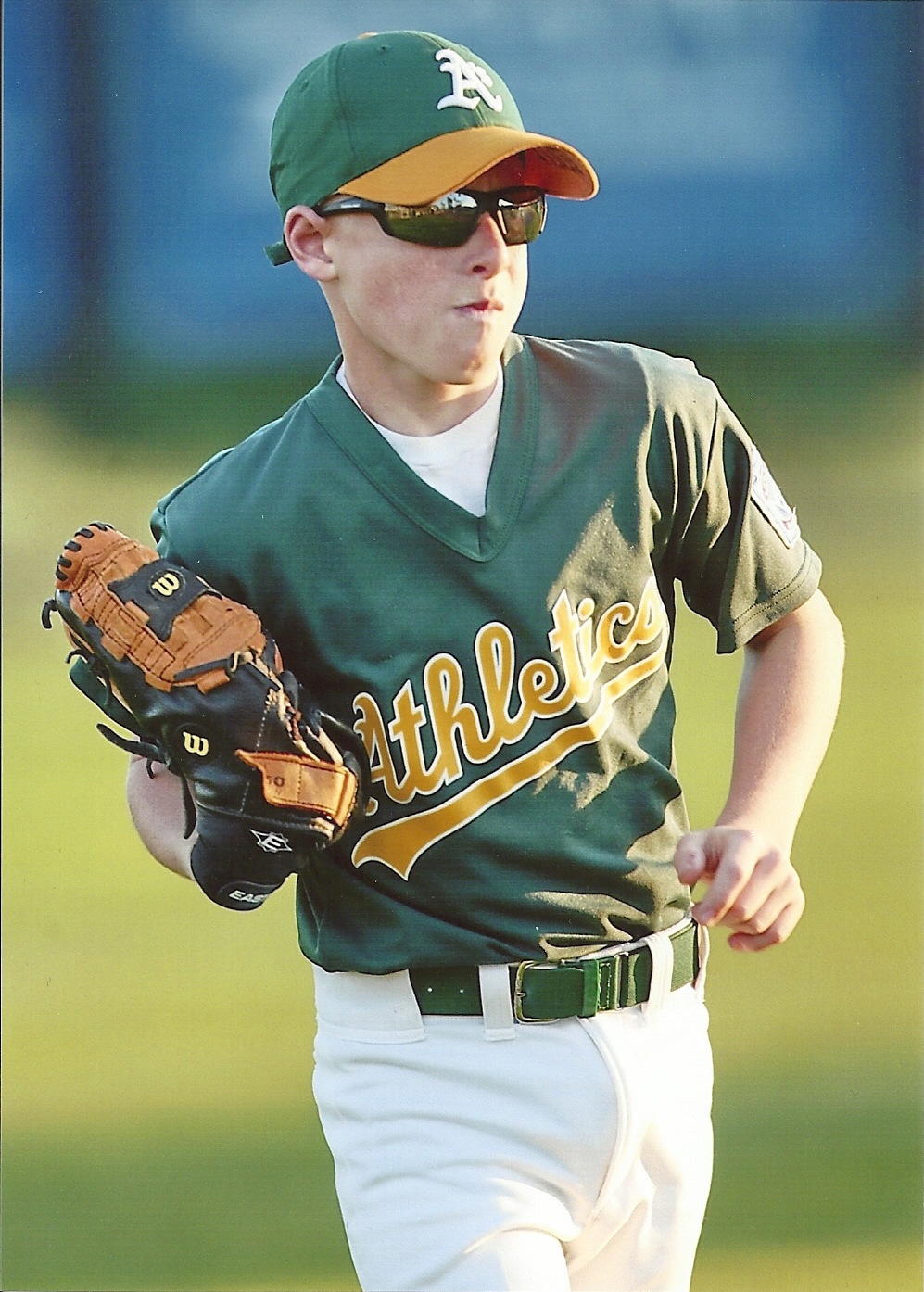
Erik Robinson was 12 years old in April 2010 when he accidentally strangled himself. He had just returned home from a Boy Scouts weekend retreat, where he earned an award for leadership, when he wrapped a rope around his neck and hung it from the pull-up bar in the kitchen of his family’s two-bedroom apartment in Santa Monica, Calif. He was seeking the moment of lightheadedness and euphoria that comes from breathing again after temporarily cutting off the flow of blood and oxygen to the brain. Instead, he died. The cause listed by police: the “Choking Game.”
“I missed him by a few minutes,” says Erik’s mother, Judy Rogg, who found her son slumped over in the doorway with his Boy Scouts rope, which he had used to practice knots, tied around his neck.
Rogg clawed at the rope as Erik hung, limp but still alive. When she could not undo the intricate slipknots, the single mother ran outside into the rain, screaming for help. A neighbor heard her and rushed over, removed the rope from Erik’s neck and gave him CPR. But it was too late. Erik was brain dead, and at the hospital the following day, Rogg removed her only child from life support. “It was every parent’s worst nightmare,” she says.

Hundreds of families have endured that same nightmare. In the U.S. alone, 82 children between the ages of 6 and 19 died after playing the Choking Game between 1995 and 2007, the most recent year with data available, according to the Centers for Disease Control and Prevention. Most of them were boys between the ages of 11 and 16, according to a 2008 CDC report citing news stories and families’ own accounts. The federal government has not studied the issue since then, but there’s no sign the deaths have slowed. More than 1,400 children and teens died from accidental hanging and strangulation from 2000 to 2015, according to the CDC. That’s similar to the number of children and teens who died in accidental shootings — about 1,900 — in the same time period. And advocates fear the problem may be worsening.
The Choking Game’s instructions were once spread through word of mouth and carried out in pairs or groups, with one child squeezing air out of another but stopping just short of the danger point. Now, with millions of how-to videos on asphyxiation only a finger’s tap away, kids are more likely to play the so-called game alone, choking themselves in their bedroom with their own belts and shoelaces, advocates say. Without the safeguard of a fellow player, what was intended as a momentary high can easily turn fatal. “It’s gotten more extreme,” Rogg says.
A quick YouTube search turns up more than 36 million results for “how to play pass out game” and more than half a million more for “how to play choking game,” which include everything from news reports to homemade tutorials. In one video, titled “Choking game,” a young boy struggles to choke himself with his bare hands but ends up wheezing instead of passing out. “I want to do it so bad, but I can’t just do it,” the boy says in the video, which was viewed more than 2,000 times from when it was posted in November 2015 until YouTube took it down two years later.
As the number of victims has mounted, a group of grieving parents, mostly mothers, have mobilized to spread an urgent message to technology companies, the country’s policymakers and schools, but they often feel like no one is listening. The federal government no longer studies Choking Game deaths, so there is no recent national data on the problem (the CDC declined to say why the deaths are not tracked). Many coroners are not trained to identify it, so the deaths can often be misclassified as suicides, according to several coroners across the country. Many schools are reluctant to raise awareness about the dangers of the Choking Game, fearing the lesson could backfire, teaching students how to play the game instead. Companies like YouTube and Facebook have begun to take action against disturbing videos, which show the Choking Game being played with belts or ropes, but advocates argue the video giants aren’t responding quickly enough.
Sharron Grant started the nonprofit Games Adolescents Shouldn’t Play (GASP) when her 12-year-old son Jesse died in 2005 after he played the Choking Game with a rubber computer cord and accidentally suffocated. She has been frustrated at how difficult it’s been to stop other children from dying in the same, preventable way. “It’s heartbreaking,” she says, “that we can’t make a difference.”
‘I Hope I Don’t Get Hurt’
The Choking Game’s origins are murky, but anecdotal evidence suggests children have been playing versions of it since at least the 1930s. (Some experts say it’s been around as long as kids have been curious.) It’s been known by different names —“Pass-Out Challenge,” “Flatliner,” “Space Monkey” — but the goal has remained the same: get high through temporary asphyxiation. While some may draw a connection between the Choking Game and autoerotic asphyxiation, a sexual act involving the deprivation of oxygen to stimulate arousal, experts believe that in the case of these children, it’s more about seeking a sense of euphoria.
The game is based on the idea that, if stopped soon enough, it leaves no lasting damage, but that’s often not the case. Brain cells begin dying within minutes of blood and oxygen deprivation, and if the carotid arteries in the neck are compressed by a rope or a belt, it can lead to irreversible brain damage after five minutes, says Dr. Katherine Thomas, who chairs the department of neurology at Intermountain Medical Center in Salt Lake City. “If you’re going to do it repeatedly, and you reach the point of having actual permanent cell death, then that could be addictive,” she says.
Add in the fact that a child’s brain is still developing, and experts say preteens and teens are uniquely susceptible to the lure of the Choking Game. “The ability to think about and anticipate the future consequences and act is something that develops gradually,” says Temple University psychology professor Laurence Steinberg. “An 11-year-old, first of all, doesn’t realize what could happen. And even if he could realize what could happen, he’s probably not imagining it could happen to him.”
While the CDC no longer studies the Choking Game nationally, a handful of states have recently chosen to ask children about it through the CDC’s annual Youth Risk Behavior Surveillance System. Five states added questions about the Choking Game to their risk assessments between 2008 and 2017, and the results showed many middle school students were familiar with it. In Oregon in 2008, about 36% of eighth graders said they were aware of the game, while 6% said they had played it. In Kentucky, Montana, Florida and Utah, about 7% to 10% of students said they had either been choked by someone or purposely tried to choke themselves for the feeling or experience it caused.
Levi Draher had already played the Choking Game three times when he slung a climbing rope across a bunk bed frame at his boarding school in Harlingen, Texas and leaned his neck into the rope on Oct. 28, 2006. Draher, who was 15 at the time, had learned the game through friends, who were playing it too. “It felt good,” he says. “That’s why.”
Draher expected to roll over and fall off the rope once he passed out, but his body stayed put. He says he was lying on the rope, unconscious and not breathing, for about 15 minutes before he was found. He had a heart attack and spent three days in a coma as his organs failed. Despite the odds, Draher emerged from the coma and recovered, though he suffers from short-term memory loss and has motor skills damage, including tremors in his hand.
“I died and came back,” says Draher, who went on national television months after the incident to warn others about the serious consequences of the Choking Game. “Almost immediately, I looked at life in a completely different way.”
He is now a father to two young children and works at a discount sporting goods store’s warehouse in Kansas while also training in jiu-jitsu, a martial art. Draher urges anyone who will listen against playing the Choking Game. “Make the right choice to live,” he says.
That’s a harder message to spread when millions of videos referencing the Choking Game are so easily accessible online, and children continue recording their dangerous experiments.
Fourteen-year-old Carson Steele used his cell phone to take videos of himself hanging by a belt inside his bedroom closet in Rock Hill, South Carolina in 2016. In one of the videos, according to his mother, Carson says: “O.K. I’m getting ready to do this. I hope I don’t get hurt.”
“You would kind of see him drop and you would hear it, and it would be an audible sound of the belt restricting his air,” recalls Carson’s mother, Jennifer Steele. “You would hear Carson gasp and you would see his feet dangling.”
Carson died on June 18, 2016. His parents and twin brother found him hanging inside his bedroom closet with a belt wrapped tightly around his neck. Carson, who had aspired to become a U.S. Marine, had been playing the Choking Game for at least two months and had recorded himself at least four times, his mother says. “There’s not a lot of laughter in our house anymore,” Steele says. “We’re very different people.”

In December 2017, YouTube announced it would amp up efforts to stop the spread of potentially dangerous videos by hiring more people to scour its website and take down videos that threaten child safety, including Choking Game-related footage. In a statement, the company said its guidelines “prohibit content that’s intended to encourage dangerous activities that have an inherent risk of physical harm.” “We work to quickly remove flagged videos that violate our policies,” a YouTube spokeswoman told TIME. On Dec. 4, 2017, the company said it had reviewed nearly 2 million videos for violent, extreme content and removed more than 150,000 of those videos since June. A YouTube spokeswoman did not specify how many of the videos pulled were related to the Choking Game or provide more recent figures. The announcement came after the New York Times in November 2017 reported on a number of violent videos found on the family-friendly YouTube Kids app, including one in which some of the characters of the popular animated children’s series PAW Patrol are brutally killed.
Anti-Choking Game advocates say children also post how-to videos on other platforms, including Facebook and Snapchat. On Nov. 3, 2017, in response to a request for comment from TIME, Facebook said it had been investigating the issue for the last 15 months, after hearing rumors about the Choking Game, but did not find any related videos on its platform. Snapchat, an app that sets itself apart through the impermanence of its video and photo messages, did not comment.
YouTube’s latest attempt to crack down on inappropriate content is a good first step, Rogg says, but is only a temporary fix because there’s nothing to stop teens from continuing to post new videos. “It’s really a whack-a-mole job,” Rogg says. “For every one that comes down, another 10 go up.”
‘I Wish I Had Kissed Him Goodbye’
On Aug. 31, 2016, Stacy Pope took a quick trip to the supermarket and left her 11-year-old son Garrett in the kitchen, doing his homework. When she returned to her family’s home in Indian Land, S.C., Garrett was no longer where she had left him. Pope sent her two youngest children, 4-year-old Jackson and 6-year-old Mollie, to fetch their brother and tell him to get ready for dinner. But the two siblings emerged from their older brother’s bedroom puzzled. “Garrett is pretending to sleep with a belt wrapped around his neck,” Jackson told his mother.
Pope rushed into Garrett’s bedroom and saw her 11-year-old boy lifeless, on his knees. Garrett had taken the cloth belt off his school uniform, tied it around his neck and then hung the other end from the top of one of his bunk bed posts. “He was already gone,” Pope says. “His lips were gray. He just had a smell to him. I remember screaming a scream that had never come out of my mouth in my life.”
Pope cried as she loosened the belt, gave her son CPR and called 911. Jackson and Mollie were sitting inside the room, watching. “I wish I had looked at him a little longer. I wish I had kissed him goodbye,” Pope says.

After Garrett’s death, Pope was wracked with guilt, thinking her son had committed suicide. She couldn’t come up with a reason why he would kill himself, but she had no other explanation. That is until the coroner investigated and determined it was the Choking Game. “Then I connected the dots,” Pope says.
A week before his death, Garrett came home with red marks on his neck. He claimed it happened after wrestling with a friend, and Pope thought perhaps his pet allergies were acting up. But Garrett—a rambunctious, playful boy—had also been sluggish days before his death, his mother says. At the time, Pope was unaware those are warning signs of the Choking Game. “Now I look back, and say, ‘Oh, my Lord. He had been doing it for a good week,’” she says.
For two weeks after his death, Pope kept Garrett’s bedroom door shut. When she finally walked inside, she wept and apologized to him. “I said, ‘I’m so sorry. I’m so sorry, buddy. But I’m going to make it up to you,’” Pope recalls.
The 42-year-old former teacher decided to join the fight against the Choking Game. In October 2016, Pope met with Steele, the South Carolina mother who had just lost her son Carson to the game, and Rogg. The three grieving families met for dinner at a restaurant in Rock Hill, S.C., where they swapped stories about their sons. “It was sad. Here we are sitting, talking about our boys,” Pope says. “If I see how sad the three of us are, I don’t want to see another mom sad like this.”
When the dinner was over, the parents made their way to Sullivan Middle School in Rock Hill, where they hosted a two-hour educational forum about the Choking Game for about 125 parents and students. “That sadness turns into strength,” Pope says.

‘It’s Dangerous for Us to Ignore It’
Rogg, who started the nonprofit Erik’s Cause after her son’s death, worked for years to develop her own training program to help schools to teach kids about the dangers of the game without using graphic, specific language. For example, Rogg and Stephanie Small, the nonprofit’s cofounder, never touch their necks while they’re speaking to the students. “We don’t show kids how to do it. We talk about what goes on in the brain and why it’s so important to keep their brain healthy,” says Rogg, 66, a retired social worker.
In 2014, the program—which consists of a 8-minute video and PowerPoint presentation—was adopted for the first time by the Iron County School District in Utah after four children in the district died from playing the Choking Game in a three-year period. Two of the deaths in 2011 were weeks apart. All four children had played the game alone, according to Cedar City police detective Mike Bleak, who was involved in the investigations and urged school leaders to implement Rogg’s program. “It breaks my heart to have to investigate dead kids,” he says. “If I could prevent that, I’m in.”
About 10,000 students have gone through the program since its implementation. No other child in the school district has died by accidental hanging or strangulation since, according to Bleak and Jennifer Wood, who recently retired as the district’s director of secondary education. They credit that success to education. “It’s dangerous for us to ignore it and just let YouTube show them how to do it,” Wood says. “Knowledge is power. We just feel good that we’re not ignoring this.”
In addition to pushing for more awareness about the Choking Game, advocates are also trying to get better data on the problem. They want the CDC to include questions on it in its main annual youth surveys. The CDC declined to answer a question from TIME about whether that change could be made. The advocates also want to educate local coroners about how to distinguish between suicide deaths and the Choking Game.
“It is a very difficult diagnosis to make but investigation is key,” says Priya Banerjee, a forensic pathologist in Rhode Island. The only clear sign of a suicide is if a note is left behind, but there are other ways to decipher what happened. Choking Game players are more likely to be found with their feet or knees on the ground. Investigators might also look for previous markings on the top of bedframes to see whether the Choking Game has been played before.
“You have to look at all the physical evidence on the scene, and then you have to sit and ask the hard questions [to parents],” says Lancaster County Coroner Karla Knight Deese, who was trained to recognize Choking Game deaths by the South Carolina Coroner’s Association. That training helped her determine that Garrett Pope did not commit suicide. “It’s a very delicate process,” she says.
‘I Have to Keep Busy’
Rogg is reminded of her son’s death every day. Some of Erik’s ashes are inside a necklace that dangles near her heart. The rest are kept inside an ammo box at home—a perfect spot, Rogg says, because Erik had dreamed of becoming a soldier. At age 12, he could handle a rifle with professional ease and Rogg says he had even been in touch with the U.S. Military Academy Preparatory School in West Point.

On top of her part-time job as a human resources consultant, Rogg dedicates about 20 hours a week to Erik’s Cause. In 2017 alone, she traveled twice to Utah to give teachers a refresher on her program and had speaking events in Pennsylvania, California and Maryland. In October, she flew across the country to stay with a New Jersey family who had just lost a child to the Choking Game. “This is the best way for me to preserve his legacy,” Rogg says. “I am very, very broken. I have to keep busy, otherwise I’m just staring at the walls.”
More Must-Reads From TIME
- The 100 Most Influential People of 2024
- Coco Gauff Is Playing for Herself Now
- Scenes From Pro-Palestinian Encampments Across U.S. Universities
- 6 Compliments That Land Every Time
- If You're Dating Right Now , You're Brave: Column
- The AI That Could Heal a Divided Internet
- Fallout Is a Brilliant Model for the Future of Video Game Adaptations
- Want Weekly Recs on What to Watch, Read, and More? Sign Up for Worth Your Time
Contact us at letters@time.com